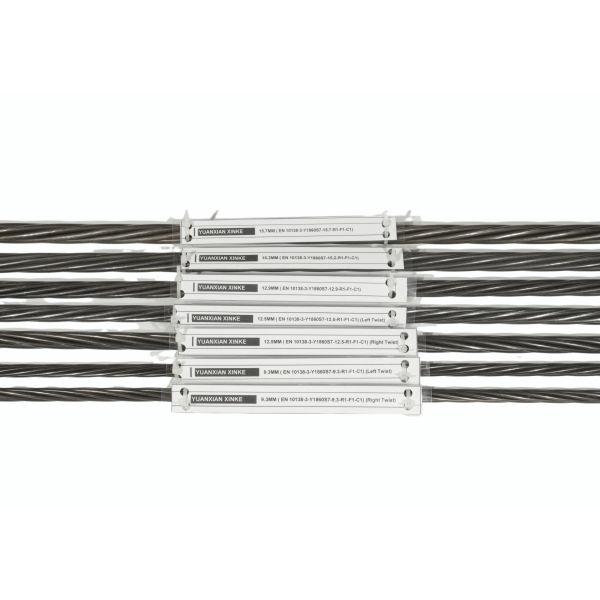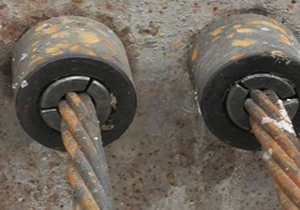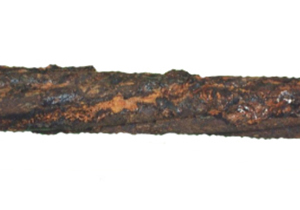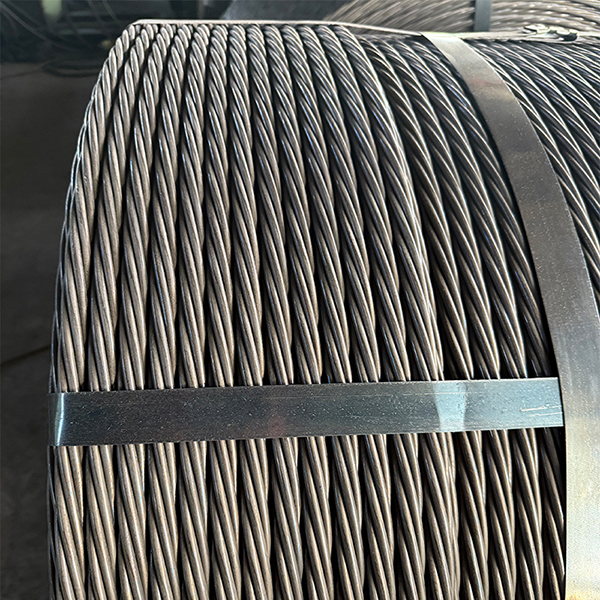+86 022 2376 3704
+86 022 2376 3704
May. 29, 2025
As the core bearing material of engineering structures, the durability of PC steel strands is directly related to the safe service life of infrastructure such as buildings and bridges. The oxidation and rust morphology (yellow rust and red rust) on the surface of steel strands is an intuitive representation of the corrosion process. Scientifically identifying the characteristics of the two and taking targeted protective measures are of great engineering significance for extending the life of components and avoiding safety risks.

Ⅰ, Yellow Rust (floating rust) is a typical manifestation of "rust" on steel strands. Timely treatment can prevent corrosion from expanding.
-- Yellow rust is the primary product of oxidation corrosion on the surface of steel. It is yellow-brown or light brown. Its main component is iron oxide containing crystal water (Fe₂O₃·nH₂O). Its formation is closely related to the short-term corrosion environment:

1. Cause Analysis
- Electrochemical corrosion starts: When the steel strand contacts moist air (relative humidity > 60%) or liquid water, an electrochemical reaction occurs with the participation of oxygen, generating a loose and porous hydrated iron oxide layer.
- Local failure of the protective layer: Scratches on the galvanized layer, wear on the oil coating layer, etc., lead to local exposure of the steel, and selective corrosion occurs in low-concentration salt spray (such as inland environment) or weak acid mist.
- Environmental characteristics: short-term storage in the open air, rain during transportation, or temporary construction exposed to a humid environment (such as foundation pit operations in the rainy season).
2. Typical characteristics
- Physical properties: Rust thickness is usually less than 0.1mm, can be easily wiped off with fingers, and cross-sectional loss rate is less than 5%.
- Color gradient: It changes from light yellow to brownish yellow with humidity, the color is lighter in dry environment and slightly darker in humid environment.
3. Performance impact
- Mechanical properties are less affected: the cross-sectional loss is slight, the yellow rust is the initial stage of rust, the rust layer is thin and attached to the surface, the cross-sectional area of the steel is usually reduced by less than 5%, and the impact on tensile strength and yield strength can be ignored.
- Toughness is basically unchanged: the rust does not penetrate into the steel, and does not affect the overall ductility and impact resistance of the steel strand.
- Durability risk: If not treated, the hygroscopicity of the rust layer will accelerate the corrosion process and gradually transform into red rust.
4. Treatment methods
- Mild: sandpaper polishing, mechanical rust removal or wiping with citric acid or oxalic acid solution (need to be diluted before use to avoid corrosion of metal).
- Severe: sandblasting rust removal, chemical rust removal (such as hydrochloric acid pickling, but the concentration must be controlled to prevent over-corrosion), anti-rust paint must be applied after treatment.
5. Prevention strategy
- Storage environment control: warehouse humidity ≤50%RH, use overhead cushion (height ≥300mm) to isolate ground moisture;
- Temporary protection: cover with waterproof tarpaulin when stacking in the open air, and focus on protecting key nodes such as anchors.
Ⅱ, Red Rust (thick rust) is a "danger signal" of steel strand corrosion. Timely intervention can effectively control risks and avoid safety accidents.
-- Red rust is a product of deep corrosion of steel. It is reddish brown or brownish red. Its main component is dehydrated iron oxide (Fe₂O₃·H₂O), which indicates that the corrosion has entered an irreversible stage.

1. Rust-causing conditions
Long-term high-corrosion environment:
- Coastal areas (Cl- concentration > 100mg/m³) or industrial pollution areas (SO₂ > 0.1ppm);
- Underwater structures (such as pile foundation steel strands) immersed in electrolyte solutions for a long time.
- Corrosion process escalation: When the yellow rust is not removed, Fe₂O₃·nH₂O gradually dehydrates, and the volume expansion rate reaches 2-4 times, aggravating the cracking of the rust layer and oxygen intrusion.
2. Characteristic identification
- Color: typical reddish brown, may become darker (close to brownish red) as the degree of rust deepens;
- Texture: rust layer thickness >0.5mm, loose and porous, easy to peel off, no protective effect, obvious pits can be seen (depth ≥0.3mm), will continue to "inwardly" corrode the internal steel wire structure of the steel strand;
- Distribution: may be spotted, flaky or fully covered, commonly seen in steel strands stored in the open air or in long-term dampness.
3. Performance impact
- Significant decrease in mechanical properties: Rust will weaken the cross-sectional area of the steel wire. The red rust layer is thick and loose. The rust penetrates deep into the steel wire, and the cross-sectional area loss can reach 10%~30%. The tensile strength decreases by 15%-25%. The elongation (Agt) is lower than 3.5% (the standard requires ≥3.5%), which may cause breakage. When used in bridges, buildings and other projects, it may cause structural safety hazards (such as prestress loss).
- Durability deterioration: Continuous corrosion of red rust will accelerate the aging of steel strands and shorten their service life. Rust destroys the crystal structure of steel, making the steel strands brittle and prone to sudden breakage (especially under vibration or load).
- Stress concentration: Stress concentration points are formed at rust pits, which may cause crack propagation and reduce fatigue life (such as higher risks when used in bridges and anchor cables).
- Scenario prohibited by regulations: If the red rust steel strand is severely corroded (such as broken wires, wire diameter reduction exceeding the standard), the building regulations clearly prohibit its use in load-bearing structures.
4. Treatment methods:
Mild red rust:
- Mechanical rust removal: Use a wire brush, sandpaper or sandblasting to remove the rust layer, then clean and apply anti-rust grease or anti-corrosion paint (such as epoxy resin).
- Chemical rust removal: Use a weak acid solution (such as phosphoric acid, citric acid) to wipe, rinse and dry after reaction (avoid excessive corrosion of the parent material).
Severe red rust:
- If the rust has caused the steel wire to become significantly thinner or broken, it must be scrapped directly and cannot be used in key projects.
- If it needs to be downgraded (such as non-load-bearing scenarios), professional testing is required to evaluate the strength of the remaining steel strands.
5. Preventive measures
- Strengthen surface protection: Use hot-dip galvanizing, epoxy coating, galvanized aluminum alloy and other processes to isolate steel from corrosive media.
- Store in a dry and ventilated place, avoid open-air stacking; cover with moisture-proof cloth, and raise the bottom to prevent moisture.
- Regularly check the appearance of installed steel strands (such as bridge cables) and deal with rust in time if found.

Crisis signals of prestressed steel strands --- yellow rust and red rust? (II)
How can mining steel strands support the thousand-ton load of mining projects?
Whether you'd like to get more info on what, need help with what you're creating anytime… anywhere.
Yuanxian High-tech Material is a company serving a worldwide customers base providing innovative and reliable product solution that recognizes the value of customer care.
Quick Links
Product Category
Subscribe Newsletter
Welcome to subscribe toour email message!
